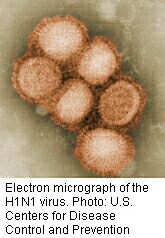
TUESDAY, Nov. 26, 2013 (HealthDay News) — The worldwide death toll from the 2009 swine flu pandemic was about 11 times higher than previously estimated, according to a new study.
More than 60 researchers in 26 countries concluded that the outbreak of the H1N1 virus caused up to 203,000 deaths worldwide. The findings were published online Nov. 26 in the journal PLoS Medicine.
The World Health Organization had said there were about 18,500 laboratory-confirmed deaths. That was widely regarded as a low number, however, because it was based only on people with confirmed cases of H1N1.
“This study confirms that the H1N1 virus killed many more people globally than originally believed,” study lead author Lone Simonsen, a research professor in the department of global health at the George Washington University School of Public Health and Health Services, said in a university news release.
“We also found that the mortality burden of this pandemic fell most heavily on younger people and those living in certain parts of the Americas,” she said.
The WHO’s lower number of confirmed deaths led some to say the public health response to the outbreak was excessive. But these new findings — based on an analysis of data from the WHO and from 21 countries accounting for about 35 percent of the world’s population — suggest that the virus was extremely dangerous.
People younger than 65 accounted for 62 percent to 85 percent of patients who died in the 2009 pandemic. This high death toll among younger people is in contrast to seasonal flu, which poses the greatest threat to seniors.
The researchers also found that certain countries had much higher death rates than others. For example, Argentina, Brazil and Mexico had the highest death rates, while the toll was much lower in Australia, New Zealand and most parts of Europe.
Learning more about these types of outbreaks is important in order to plan and prepare for the next pandemic, Simonsen said.
More information
The U.S. Department of Health and Human Services has more about H1N1 swine flu.
Copyright © 2025 HealthDay. All rights reserved.

